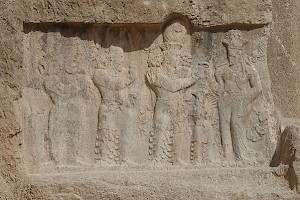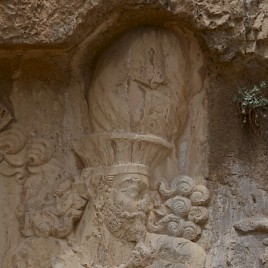Naqš-e Rustam, Relief of Narseh
Q70787008Naqš-e Rustam: archaeological site in Fars (Iran), best known for its Achaemenid tombs and rock reliefs made in the Sasanian age.
Relief of Narseh

The Investiture of the Sasanian king Narseh (r.293-303) is carved into the rocks near the tomb of Darius I the Great. The king, the second large figure from the right, receives the cydaris ring from a probably female figure. A young prince is standing between them. To the left are two imperial grandees.
Narseh, a younger son of the great Shapur I, had served as ruler of the eastern provinces (e.g., Sistan) during the reign of his nephew Bahram II, but had come to power by a coup d'état, deposing Bahram's son and successor, Bahram III. That he was not a lawful ruler may explain that he does not receive the cydaris from Ahuramazda, but from a women: she may be Shapurdokhtak, the king's wife, through whom Narseh was entitled to the throne.

Alternatively, she may be Anahita, the goddess of the waters, families, and fertility, but the fact that king Narseh does not salute her as befits a worshipper in front of a deity, seems to contradict this interpretation of the ancient relief. On the other hand, it is often assumed that the cult of Anahita became popular during the reign of Narseh.
The identity of the little prince is less problematic: he must be the king's son Hormizd II, who succeeded his father.
Behind the king, we can see two important courtiers, making the gesture with the fist and index finger that expresses respect for the king. This gesture can be seen on countless Sasanian reliefs.
There is no triumph relief of Narseh, neither at Naqš-e Rustam nor at another place. This comes as no surprise, because the king was defeated in 297 by the Roman emperor Galerius and was even forced to give up parts of Armenia. It was a sign of the times: after the reign of Shapur I, the Sasanian empire was weak and divided, which can also be deduced by the rapid succession of kings.
 Naqš-e Rustam, Investiture relief of Narseh, courtier |
 Naqš-e Rustam, Investiture relief of Narseh |
 Naqš-e Rustam, Investiture relief of Narseh |
 Naqš-e Rustam, Anahita (?) |
Literature
Louis Vanden Berghe, Reliefs rupestres de l' Iran ancien (1983 Brussels), #75.